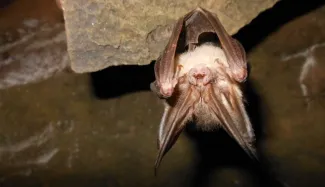The Wildlife Department is the state agency responsible for managing, protecting, and enhancing the wildlife species and habitats found within our boundaries. But some of our species have become so imperiled they require another layer of protection. This protection comes from the federal government in the form of the Endangered Species Act.

The Ozark big-eared bat is a federally endangered subspecies.
History of the Act
The ESA was established in 1973 in response to the growing concern that many of our nation’s native plants and animals were in danger of becoming extinct. Additionally, Congress recognized the rich natural heritage of the nation was of “esthetic, ecological, educational, recreational and scientific value to our Nation and its people.” The ESA is administered by the U.S. Fish and Wildlife Service, a division of the Department of the Interior.
How the Endangered Species Act Protects Our Wildlife
The ESA makes it unlawful for any person or entity to “take” a federally listed species. Take is a specific legal term that refers to any action that would harass, harm, pursue, hunt, shoot, wound, kill, trap, capture, or collect or attempt to engage in any such conduct. Even so, the U.S. Fish and Wildlife Service will issue permits for take through Section 10 of the ESA. With permitting, any disturbance is documented and reviewed. Additionally, this permit often requires specified conservation measures be conducted that benefit the federally listed species.
For some listed species, habitat protection is essential to conservation efforts. In these cases, the USFWS may designate “critical habitat.” Critical habitat is defined as geographic areas that contain the physical or biological features essential to the conservation of the species. The features considered vital for conservation vary from species to species and may be harder to determine for those utilizing a wide array of habitat types.
How Species Become Listed
To receive the added protection of the ESA, each petitioned species must undergo a thorough review. This requires an in-depth assessment of the species’ population; existing threats to the species or habitat including overutilization, disease, or predation; other natural or manmade factors that may affect the continued existence of the species; and ongoing recovery efforts. Depending on the findings of the review, the USFWS may announce the petitioned listing as:
- Unwarranted – If the species does not meet the requirements of the ESA, the listing is considered unwarranted. Management and protection remain under state authority.
- Warranted but precluded – If the species meets the requirements of the ESA, but other species receive higher prioritization, the listing is considered warranted but precluded. Management and protection remain under state authority. Even so, the species will be considered a “candidate species” and listing will be reconsidered at a later date.
- Threatened – If the species meets the requirements of the ESA and it is found the species will become endangered within the foreseeable future, it is federally listed as “threatened.” For some species, management efforts can remain under state authority through a special ruling, but protection is provided under federal authority.
- Endangered – If the species meets the requirements of the ESA and it is found the species is in danger of extinction throughout all or a significant portion of its range, it is federally listed as “endangered.” Management and protection is provided under federal authority.
How Oklahoma Is Involved in the Endangered Species Act
The Wildlife Department is an active partner in the conservation and management of listed species. Biologists assist the USFWS with annual surveys for the threatened Arkansas river shiner and leopard darter and manage habitat for the red-cockaded woodpecker on the McCurtain County Wilderness Area. Additionally, we are involved in the coordination of many federal grants related to listed species.
ODWC’s Wildlife Diversity Program also funds research to better understand the population status and distribution of many at-risk and candidate species through the State Wildlife Grant program. This research often assists with future USFWS listing decisions.
Success Stories
The ESA has allowed for “full recovery” of several once-listed species such as the bald eagle, peregrine falcon, and American alligator. Other species, like the black-footed ferret, have benefited from ESA captive breeding programs that have increased the total population from a mere 18 individuals in 1986 to a current population of over 1,200.